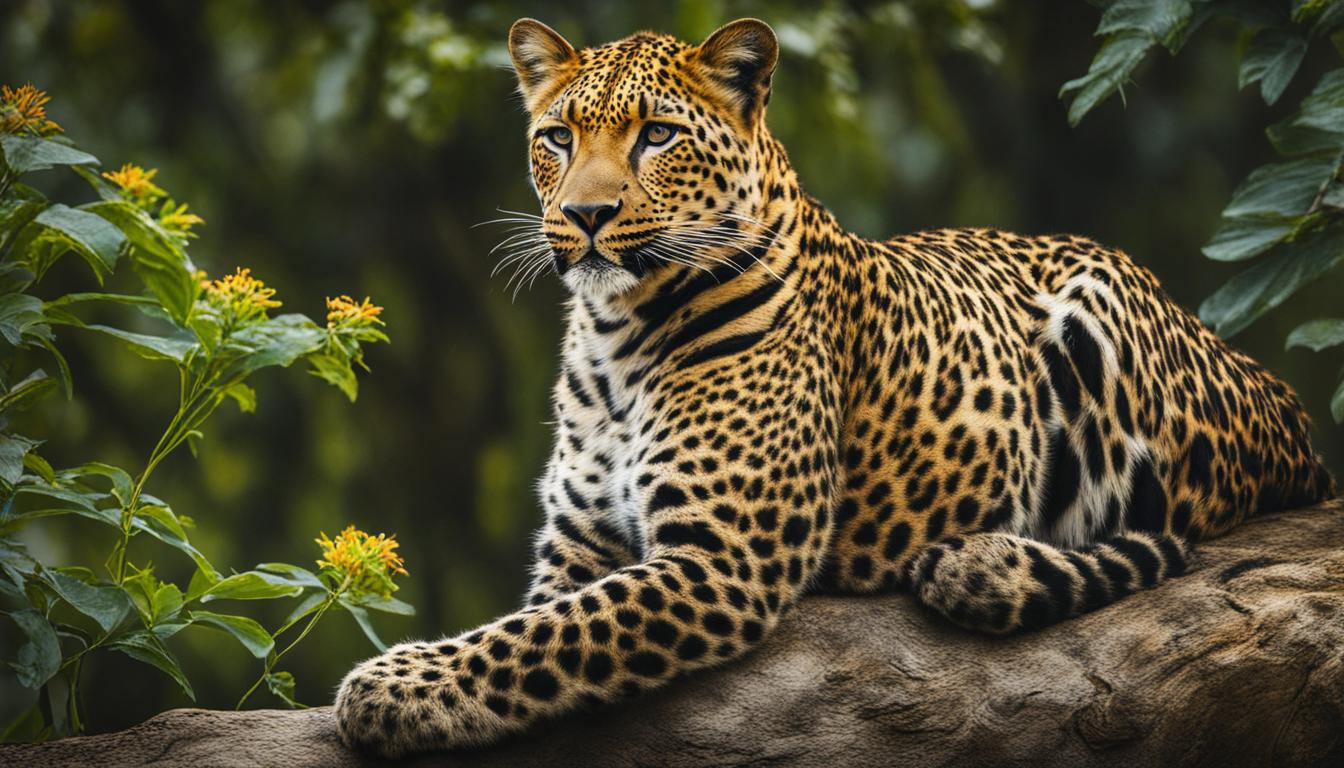Leopard spots have long fascinated both scientists and fashion enthusiasts alike. These unique markings not only serve a vital purpose in the wild but have also become a popular trend in the fashion world.
Leopard spots, also known as leopard print, have found their place in the latest fashion trends, adding a touch of allure and sophistication to clothing, accessories, and even interior design. However, their significance goes beyond fashion statements.
These spots are not just a style choice; they are an essential adaptation that helps leopards survive in their natural habitats. The camouflaging effect of the spots allows leopards to blend seamlessly into their surroundings, making them skilled hunters who can approach their prey undetected.
But it’s not just about fashion and survival. Preserving wildlife and their habitats is crucial for the overall health of ecosystems and the protection of biodiversity. By understanding the importance of leopard spots and supporting wildlife conservation efforts, we can ensure the continued existence of these majestic animals and their magnificent markings.
The Evolution of Leopard Spots
Scientific research has shed light on the fascinating evolution of leopard spots. These distinctive markings on a leopard’s coat have long been admired for their beauty and camouflage capabilities. Through extensive study and analysis, researchers have discovered that leopard spots are not randomly distributed but are actually a result of the cat’s surroundings and hunting habits.
According to scientific findings, leopards that hunt on open, rocky ground during daylight hours tend to have plain-colored coats. This helps them blend into their environment and remain inconspicuous while stalking their prey. On the other hand, leopards that hunt from rainforest tree branches have developed dappled fur. These spots mimic the patterns of sunlight filtering through the dense foliage, providing them with effective camouflage in their natural habitat.
Furthermore, leopards inhabiting dense, dark forests have evolved complex and irregular markings. These spots serve a dual purpose: they help the leopards blend seamlessly into their surroundings, and they enhance their ability to hunt nocturnally. The intricate patterns aid in breaking up their silhouette, making it difficult for potential prey to detect their presence. This adaptation has allowed leopards to become highly successful hunters.
The research on the evolution of leopard spots provides valuable insights into the genetic and adaptive mechanisms behind the development of these intricate patterns. It demonstrates the remarkable ability of organisms to adapt to their environment and maximize their chances of survival. By understanding the evolutionary history of leopard spots, scientists can gain a deeper understanding of the complex relationship between genetics, behavior, and environmental factors in the animal kingdom.
The Evolution of Leopard Spots
| Leopard Habitat | Coat Pattern |
|---|---|
| Open, rocky ground | Plain-colored coat |
| Rainforest tree branches | Dappled fur |
| Dense, dark forests | Complex and irregular markings |
This table summarizes the correlation between leopard habitat and coat patterns, showcasing the remarkable adaptability of these majestic creatures. It exemplifies the fascinating ways in which nature has shaped the evolution of leopard spots, enabling them to thrive in diverse environments.
Camouflage and Survival
The spots on a leopard’s coat, along with other markings like stripes, serve as a form of camouflage that helps the animal break up its outline. This camouflage is essential for predators like leopards to move and hunt undetected in their environment. The spots on a leopard’s fur blend into the shadows and sunlight patches in grasslands or forests, allowing them to sneak up on their prey. The ability to blend into their surroundings increases their chances of successful hunting and survival in the wild.
Leopards have mastered the art of blending in with their surroundings, making them highly effective hunters. Their spots provide them with the perfect disguise, making it difficult for their prey to spot them in the dense vegetation or open landscapes. This camouflage allows leopards to get close to their prey without being detected, giving them the element of surprise. By remaining hidden until the last moment, they can pounce on their unsuspecting victim and secure a successful hunt.
The intricate patterns formed by the spots on a leopard’s coat also help to break up the outline of their body, further enhancing their camouflage. This allows them to seamlessly merge with their environment, making it challenging for other animals to spot them. It is a true testament to the power of natural selection and adaptation, as leopards have evolved to become masters of camouflage, ensuring their survival in the wild.
The Role of Camouflage in Predator-Prey Interactions
The use of camouflage by leopards is not limited to hunting. It also plays a crucial role in their interactions with other predators and potential threats. By blending into their surroundings, leopards can avoid confrontations with larger predators or potential threats. They can use their camouflage to hide from other carnivores or to stalk their prey without being detected. This ability to remain hidden provides them with a significant advantage in the predator-prey dynamics of their ecosystem.
| Predator | Camouflage Strategy |
|---|---|
| Lion | Blends into grasslands and savannas |
| Cheetah | Camouflage based on speed and agility |
| Leopard | Camouflages in forests and grasslands |
As seen in the table above, each predator has its own unique camouflage strategy based on its habitat and hunting style. The leopard’s coat pattern allows it to excel in various environments, making it a versatile and successful predator. The evolution of their spots and their ability to use camouflage effectively has made leopards a formidable force in the wild, ensuring their continued survival.
Mathematical Model of Coat Patterning
A recent study conducted by Will Allen, a graduate student at the University of Bristol, has shed light on the intricate relationship between coat patterning in big cats and their environments. Using mathematical methods, Allen explored the different types of patterns that appear on the coats of wild cats, including leopards. His research revealed that cats with similar coat patterns tend to share similar ecology and behavior, indicating that coat patterning is influenced by both genetic makeup and environmental factors.
This groundbreaking study provides valuable insights into the connection between gene makeup and visible traits like coat patterns in animals. By using mathematical modeling, Allen was able to demonstrate how the interplay between genes and the environment shapes the unique markings of leopards. This research not only enhances our understanding of the evolution and adaptation of leopard spots but also lays the groundwork for future studies in the field of genetics and animal patterning.
“The mathematical model developed in this study offers a new perspective on the complex relationship between genes and visible traits. By analyzing the patterns of wild cats, we can gain a deeper understanding of how natural selection has shaped these iconic features and their role in survival,” said Allen.
The Impact of the Mathematical Model
The mathematical model developed by Allen has far-reaching implications. It can be applied to other species and help scientists unravel the intricate processes involved in the development of visible traits. Understanding the genetic basis of coat patterns can provide valuable insights into the evolution and adaptation of various animals, furthering our knowledge of biodiversity and the intricate web of life.
This research also has practical applications beyond the field of biology. The mathematical model can be used in other scientific disciplines, such as computer graphics and visual design, to generate realistic patterns that mimic those found in nature. By harnessing the power of mathematics, we can unlock the secrets of the natural world and apply them in innovative and creative ways.
| Benefits of the Mathematical Model | Applications |
|---|---|
| Enhances our understanding of genetic mechanisms | Biology |
| Contributes to biodiversity research | Conservation |
| Provides insights into animal adaptation | Ecology |
| Aids in the development of realistic visual patterns | Design |
Overall, the mathematical model of coat patterning developed by Will Allen has opened up new avenues for scientific inquiry and practical applications. By utilizing advanced mathematical techniques, researchers can uncover the intricate relationship between genes and visible traits, offering a deeper understanding of the wondrous world of nature.
The Purpose of Leopard Spots in Fashion
Leopard spots have not only captivated the scientific community but also the world of fashion. The unique pattern of leopard spots, known as leopard print, has become a popular trend in the fashion industry. Leopard print is considered an exotic print and is often used in clothing, accessories, and interior design. The spots symbolize the beauty and power of leopards and have become a fashion statement for those seeking bold and trendy styles.
| Reasons why leopard print is popular in fashion: |
|---|
| * Exudes confidence and fierceness |
| * Adds a touch of wildness and sophistication |
| * Versatile and can be styled in various ways |
| * Evokes a sense of adventure and freedom |
The popularity of leopard print highlights the enduring fascination with the markings of these majestic animals. People are drawn to the boldness and elegance that leopard spots represent. Whether in the form of a statement coat, a pair of fashionable shoes, or a trendy accessory, leopard print brings a touch of the wild into the world of fashion.
“Leopard spots are like nature’s abstract art, effortlessly blending into fashion trends and making a statement on runways around the world.” – Fashion Designer
Conservation and Wildlife Preservation
Wildlife conservation plays a crucial role in protecting the habitats and populations of endangered species, including leopards. By safeguarding their natural environments, we can ensure the long-term survival of these magnificent animals and the preservation of their unique spots. The efforts to preserve leopards and their spots are not only necessary for the well-being of these creatures but also for maintaining the balance of ecosystems.
One way to support wildlife conservation is through safari fashion, which has gained popularity in recent years. Safari-inspired clothing and accessories not only reflect the beauty and elegance of the animal kingdom but also serve as a reminder of the importance of protecting wildlife habitats. By choosing sustainable and ethically sourced fashion items, you can make a positive impact on wildlife conservation efforts. Additionally, supporting brands that actively contribute to conservation projects can further contribute to the preservation of leopard habitats.
“Conservation is a state of harmony between men and land.” – Aldo Leopold
Preserving wildlife habitats is essential not only for the survival of leopards but also for the overall health of ecosystems. The loss of natural habitats due to deforestation, urbanization, and other human activities threatens the existence of many animal species, including those with unique markings like leopards. By raising awareness about the importance of wildlife conservation and supporting organizations dedicated to protecting these habitats, we can ensure a sustainable future for both wildlife and humans.
| Threats to Wildlife Habitats | Impact on Leopard Populations |
|---|---|
| Habitat destruction due to deforestation | Loss of suitable hunting grounds and shelter |
| Poaching and illegal wildlife trade | Reduction in leopard populations |
| Climate change and habitat fragmentation | Disruption of leopard migration and breeding patterns |
Protecting leopards and their spots is not just a responsibility of conservationists and scientists but also of individuals like you. By making conscious choices in your daily life, supporting sustainable fashion, and advocating for wildlife conservation, you can contribute to the preservation of these majestic animals and their habitats for generations to come.

Conclusion
Leopard spots serve a dual purpose: camouflage for survival in the wild and inspiration for fashion trends. The evolution of leopard spots is a result of their surroundings and hunting habits, with the pattern on their coats aiding in their ability to blend into different environments.
This natural camouflage has caught the attention of the fashion industry, leading to the popularity of leopard print as a symbol of style and sophistication. However, it is important to remember that leopards and their spots are not just fashionable accessories but also living creatures that require protection and conservation efforts.
By appreciating the beauty and significance of leopard spots, you can contribute to the preservation of these magnificent animals and their habitats. Whether it’s through supporting wildlife conservation initiatives or incorporating safari fashion into your wardrobe, you can help ensure the survival of leopards and the preservation of their unique spots for generations to come.
Do Leopard Spots Serve a Purpose for Camouflage in Their Environment?
Yes, leopards’ camouflage spots in environment serve a crucial purpose. These spots help leopards blend into their surroundings, making them less visible to prey and predators alike. In their natural habitat, the distinctive pattern of their spots allows them to hunt and avoid danger more effectively.
FAQ
Why do leopards have spots?
Leopards have spots as a form of camouflage, which helps them blend into their surroundings and hunt undetected.
What determines the pattern on a leopard’s coat?
The pattern on a leopard’s coat is determined by their environment, with cats in open spaces having simpler patterns and cats in forested areas having more complex patterns.
What is the purpose of leopard spots in fashion?
Leopard spots, known as leopard print, have become a popular trend in the fashion industry as they symbolize the beauty and power of leopards and are considered an exotic print.
How do leopard spots aid in their survival?
Leopard spots serve as a form of camouflage that helps the animals break up their outline, allowing them to move and hunt undetected in their environment.
What does scientific research reveal about the evolution of leopard spots?
Scientific research indicates that leopard spots have evolved in response to the cat’s surroundings and hunting habits, with different patterns appearing based on their ecology and behavior.
What is the connection between gene makeup and coat patterns in animals?
Research suggests that coat patterning in animals is influenced by both genetic makeup and environmental factors, providing a possible mathematical model for understanding this connection.
Why is the conservation of leopards important?
Leopards play a crucial role in maintaining the balance of ecosystems and are considered a keystone species. Safeguarding their habitats and educating the public about wildlife conservation is vital for their long-term survival.







